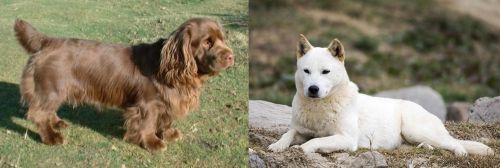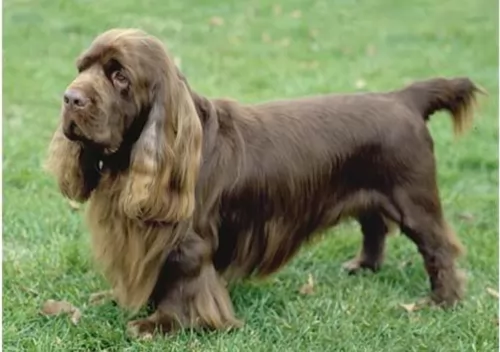 MyDogBreeds
MyDogBreeds Sussex Spaniel is originated from United Kingdom but Jindo is originated from South Korea. Sussex Spaniel may grow 27 cm / 10 inches shorter than Jindo. Both Sussex Spaniel and Jindo are having almost same weight. Both Sussex Spaniel and Jindo has same life span. Both Sussex Spaniel and Jindo has same litter size. Both Sussex Spaniel and Jindo requires Moderate maintenance.
Sussex Spaniel is originated from United Kingdom but Jindo is originated from South Korea. Sussex Spaniel may grow 27 cm / 10 inches shorter than Jindo. Both Sussex Spaniel and Jindo are having almost same weight. Both Sussex Spaniel and Jindo has same life span. Both Sussex Spaniel and Jindo has same litter size. Both Sussex Spaniel and Jindo requires Moderate maintenance.
 The Sussex Spaniel comes from Sussex in southern England. The whole purpose of his development was for him to rush between reeds, causing birds to fly up and for their owners to then shoot them so that they could retrieve them.
The Sussex Spaniel comes from Sussex in southern England. The whole purpose of his development was for him to rush between reeds, causing birds to fly up and for their owners to then shoot them so that they could retrieve them.
His history dates back to the 19th century when breeding for the dog started. The first breed standard was also written during this time.
It was about in 1969 that some of these Sussex Spaniels were imported to the United States where they were referred to as a sporting breed. Today they are still a rare breed.
 Hailing from Korea, the Jindo dog's name is actually taken from the island Jindo. The dogs lived on the island for thousands of years, developing into a natural breed with good hunting skills.
Hailing from Korea, the Jindo dog's name is actually taken from the island Jindo. The dogs lived on the island for thousands of years, developing into a natural breed with good hunting skills.
They are also known as Jin Dog, Jindo-kae or Jindo-kyon. The exact origins of the Korean Jindo are unknown and it is believed to have been developed from different Mongolian breeds.
They were brought to the United States and been entered into the American Kennel Club.
 With his low, long body and short legs, this beautiful golden liver color spaniel has long, silky ears and a long, feathery tail.
With his low, long body and short legs, this beautiful golden liver color spaniel has long, silky ears and a long, feathery tail.
He is a moderate shedder. He is quite a distinctive looking dog with his silky coat and sombre expression. You’d descibe him as medium sized dog, standing at between 33 – 38cm in height and weighing 16 -20kg.
The Sussex Spaniel is more slow and sedate than the Cocker Spaniel but he still makes an excellent pet and companion.
He is strong and robust. He is clever too, but slightly stubborn, while also being clownish and entertaining. They’re the kind of dogs who bond strongly with their family and aren’t that enthusiastic with strangers.
They take a while to warm towards people they don’t know. He is steady, reliable and determined and makes a good watchdog. Because he is gentle and even tempered he makes an ideal pet for children and he is able to get on well with other dogs too.
It’s good to have them trained and socialized as they become even more amicable around other people and dogs they don’t know.
 The Jindo is a medium sized spitz-type dog breed which is well-proportioned with erect ears and a long tail which is held over the dog's back.
The Jindo is a medium sized spitz-type dog breed which is well-proportioned with erect ears and a long tail which is held over the dog's back.
He stands at roughly 45 – 65cm and they weigh anything between 11 to 23kg. The coat of the dog is medium length and available in a number of colors – yellow, tan, red, white, brindle, black or bi-color such as black and tan.
When you look at the Jindo you get the impression of bright alertness and intelligence. He makes a great watchdog, and with his bright, alert eyes and upright ears, he just looks like he is on guard.
The Jindo has always been a hunting dog so he has learned to be bold, tenacious and alert. He is also brave, courageous, loving and loyal to his master, but you need to know that he is a dominant dog who will get on well with an owner who is fair, strong, patient, kind and firm.
These dogs are strong willed, independent and dominant as well as being intelligent. He will require socialization and training from an early age. Be fair, firm and consistent with your instructions which he will obey once he has been trained. With training he gets on well with children in the home but he is inclined to have some difficulty with accepting other dogs into the family.
As with any dog breed, the temperament of the Jindo will vary according to the environment he lives in and the type of owners he has. The typical Jindo is an affectionate dog with his human family, being a little bit reserved around strangers.
 He is a low drooling dog and he adapts easily to life with his human family, preferably in the countryside.
He is a low drooling dog and he adapts easily to life with his human family, preferably in the countryside.
He isn’t the most intelligent breed, but most people love him just like that because he’s eager to please and just wants to be your trusted, loyal pet and companion.
 The Jindo makes an awesome pet for owners who enjoy an active lifestyle. A happy, contented Jindo becomes a devoted, loyal pet who wants to guard and protect his owner from strangers, for whom he is wary and reserved.
The Jindo makes an awesome pet for owners who enjoy an active lifestyle. A happy, contented Jindo becomes a devoted, loyal pet who wants to guard and protect his owner from strangers, for whom he is wary and reserved.
He is an intelligent pet too, being easy to train and socialize and while independent, he loves to spend time with his human family and is an all-round excellent pet.
 Your Sussex, like any other dog, is going to be prone to some diseases and conditions. If you are going for a puppy, always look for a reputable dog breeder, as this at least gives your dog a better chance of a healthy life.
Your Sussex, like any other dog, is going to be prone to some diseases and conditions. If you are going for a puppy, always look for a reputable dog breeder, as this at least gives your dog a better chance of a healthy life.
This is a congenital heart disease where blood doesn't flow properly and where the right side of the heart works harder and actually enlarges.
If the obstruction is severe, it can cause arrhythmia or congestive heart failure.
If the stenosis is mild, you may not even notice any conditions, but if it's severe, your pet may have difficulty with breathing, his stomach may be distended, and with strenuous exercise he could even collapse.
This is when a disc in the spine ruptures and pushes upward into the spinal cord. It can be an injury or an inherited condition.It is painful and will include anti-inflammatory medications and possibly surgery.
 The Korean Jindo dog is looked upon as a generally healthy dog breed with no serious genetic problems to talk about. Look out for eye diseases and dental decay as well as hypothyroidism, a common disease in dogs where you notice deterioration with the coat – thinning, dry and dull.
The Korean Jindo dog is looked upon as a generally healthy dog breed with no serious genetic problems to talk about. Look out for eye diseases and dental decay as well as hypothyroidism, a common disease in dogs where you notice deterioration with the coat – thinning, dry and dull.
The dog’s skin also becomes flaky and you’ll notice that your once energetic pet is now gaining weight and is lethargic. Get him to the vet. Hypothyroidism can be treated simply by your vet to get your pet healthy once again.
 Because of the long, silky hair, brushing your Sussex twice a week will be necessary to prevent matting from dirt adhering to the fur.
Because of the long, silky hair, brushing your Sussex twice a week will be necessary to prevent matting from dirt adhering to the fur.
The insides of those long floppy ears can be a breeding spot for bacteria as they don’t easily dry. When you brush him, check inside the ears to make sure they aren't red which could be a sign of ear infection.
Remember, if you don’t like to do all the grooming chores there are, a grooming parlour will do the chores for you. They cut your dog’s hair, check inside his ears, clean his teeth and trim his nails.
Every dog needs excellent food to be healthy. Many people feed their pets the wrong kinds of foods and then wonder why they have to fork up so much on vets fees.
If you feed your Sussex Spaniel one of the commercial manufactured foods, make sure its one of the good ones packed with vitamins and minerals. Tasty home-made food added to his kibble a couple of times a week can do him the world of good if its kept simple – no spicey, exotic foods that can upset the stomach.
Boiled chicken, brown rice or pasta and spinach, sweet potatoes and carrots all chopped up and mixed into the dry kibble once or twice a week will ensure a healthy, happy pet.
To avoid skin allergies and a dull coat, try and add in some raw meat occasionally. Always make sure he has access to fresh, cool water.
These dogs have been accustomed to a life of running in open spaces and they’re going to want lots of exercise. They love ball games and they love a walk in the countryside with lots of new scents to follow.
It’s why this dog isn’t suited to life in a small city property. He needs space and the outdoors to use up his energy.
 The Jindo has a double coat and this sheds heavily about twice a year, so certainly during these shedding periods you will need to brush his coat twice a week to keep it free from loose hair.
The Jindo has a double coat and this sheds heavily about twice a year, so certainly during these shedding periods you will need to brush his coat twice a week to keep it free from loose hair.
Never just assume that your dog is healthy and happy. When you brush him, check him over for ticks and fleas, check him for any unusual lumps, make sure his nose is wet and that his eyes are bright. Look at the condition of his fur, check his teeth and inside his ears – there are lots of tell-tale signs that can indicate that all is not well with your pet and then you need to get him to the vet.
As a medium-sized breed, if you feed your dog commercially manufactured food, he will require a high quality food that has been formulated for a dog of his size and his activity levels. Mix some home-made cooked chicken, brown rice or pasta as well as vegetables into his kibble and try to include some raw meat in occasionally too. He needs to always have access to fresh, clean water.
The Jindo is a high energy dog, and with his bright face you can tell that he is always ready for action. Long ago he was bred to perform hunting and retrieving type jobs, and with their stamina, they require having a busy day.
They certainly require a significant amount of exercise and mental stimulation, so you will need to include him in your daily walks and give him exciting ball games.